I was recently in Cotonou for a 24-hour layover. Cotonou is the largest city of the small west African nation of Benin, and has become a secondary hub for emerging airline RwandAir. Taking advantage of its growing network, I booked a RwandAir ticket from Dakar, Senegal to Kigali, Rwanda via Cotonou. The transit stop included accommodation provided by the airline.
What is there to do in Cotonou? A quick Google search indicated that the closest attraction to the hotel was on the beach: an ’˜amusement park’ called Air de Jeux Plage Ervan. This ‘park’ appeared to include a large-looking aircraft, so I decided to check it out. Little did I know the airframe was a historic Lockheed L1011 TriStar, full of amazing clues about its long and varied history around the world.
Cotonou appeared relatively relaxed compared to my previous destination of Dakar. The streets were quiet and the buildings were relatively low-rise. The beach was a wide expanse of sand, far cleaner than expected, with an ocean that is uninterrupted all the way to Antarctica. It was there that the ’˜amusement park’ came into sight, and as I went closer the aircraft became clear: a white-washed Lockheed L1011 TriStar.
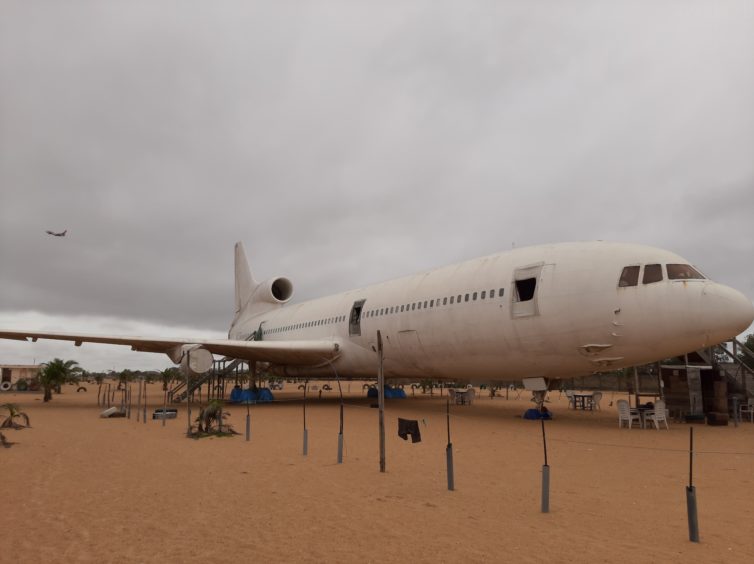
Could you imagine walking down the beach and seeing a Tristar just sitting there? Pretty awesome – Photo: Jerome de Vries
What a remarkable sight. I had always been interested in the TriStar. Perhaps for its iconic S-duct which feeds the tail engine. Perhaps because it was Lockheed’s last civilian aircraft. Perhaps because the various grounded TriStars I have seen in airports around the world. Today there is only one still operating, N140SC, which is dubbed the ’˜stargazer’ and is used as a flying rocket launcher for Northrop Grumman.
The airframe appeared to be in a decent condition, though its engines had been stripped and markings on the fuselage had been painted over. I assumed it would therefore be difficult to uncover the aircraft’s registration and ownership history. The removal of the rear engine provided a unique opportunity to view the S-duct in its entirety.
Some chairs and tables were scuttled around the aircraft, and a wooden staircase was clumsily constructed up to the forward left door. A man sat leisurely next to the staircase, clearly less excited about the aircraft than I was. He started speaking French, but could move to English easily enough. ’œGo inside, 2000 Francs’. About $3.30 USD — deal!
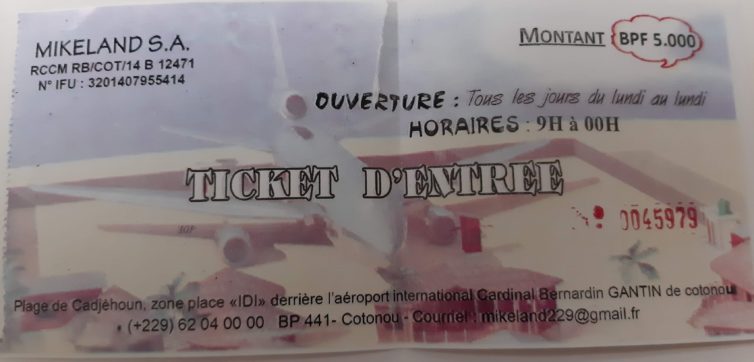
The ticket quotes a price of 5,000 West African Francs – I must have received a discount! – Photo: Jerome de Vries
I was very happy to hand over the necessary West African cash. I started to make some inquiries about the aircraft. ’œTriStar,’ he said. ’œL1011.’ ’œSierra Leone. Kambuja. Owner want to make into restaurant.’ I wasn’t sure what ’œKambuja’ meant, but was soon to find out.
I’ve seen images of abandoned aircraft around the world, including the Boeing 747 parked on private property in Bangkok. In many cases, the aircraft have their insides thoroughly stripped and show little indication of their previous owners. Flight decks often have their instruments ripped out, and I expected the same for this TriStar. However, I was to be in for an incredible surprise.
The first thing that grabbed my attention upon entering was a bronze plaque posted next to the forward door. The registration number, serial number and owner’s details were all meticulously detailed. The aircraft bore Sierra Leonian registration 9L-LFB, and last operated for Air Rum. So much for any trouble working out the aircraft’s history.
I had heard of Air Rum’s TriStar operations before. They were a Jordanian-owned charter operator in the mid-2000s that operated a fleet of five TriStars. The airline was in the headlines in 2005 for faking a fuel emergency in Peru. The captains allegedly did this to land at an airport that better suited the Gambian football fans on board. The airline was also banned from operating in the European Union. The below screenshots from their former website (recovered using the Internet Archive) don’t inspire much confidence.
The manufacturer’s plate in the doorway indicated the aircraft began its life in Burbank, California on the 8th of August 1978. Who knew that 41 years later it would rest here, on the beaches of West Africa?
The aircraft had a long and varied operational history. It started in Japan with All Nippon Airlines (ANA) as JA8522. ANA operated it for 18 years before it was sold to US-based Rich International Airways in 1996, tail number N309GB. In 2001 the TriStar was moved to southeast Asia where it operated for Kampuchea Airlines of Cambodia as XU-100. Kampuchea Airlines was partly owned by Orient Thai who also operated the aircraft. The TriStar was finally purchased by Air Rum in 2004, who named it “Barakah.” Air Rum collapsed in 2008 and left its fleet of six TriStars at various airports, including this one in Cotonou where it had been conducting hajj charters for a Cameroonian company.
“Barakah” sat in a corner of Cotonou airport until 2015 when a local businessman bought it and towed it 400 meters across the road to the beach. The plan is to make the aircraft into a restaurant, a similar fate to other preserved aircraft around the world. Four years later, there hasn’t been much progress on the project apart from the removal of the engines and the whitewashing of the fuselage. There was decay in the cabin as the doors were left open, exposing everything to the rain and sea air.
The cabin was only configured in economy class, unusual for a widebody, and had a 3-4-2 layout. This must have made it more comfortable than the famously unpopular 2-5-2 layout that some carriers opted for. The lack of overhead bins above the middle seats created a spacious feeling in the cabin. Japanese signage clearly indicated the 18 years of operation by ANA, including on the galley lifts.
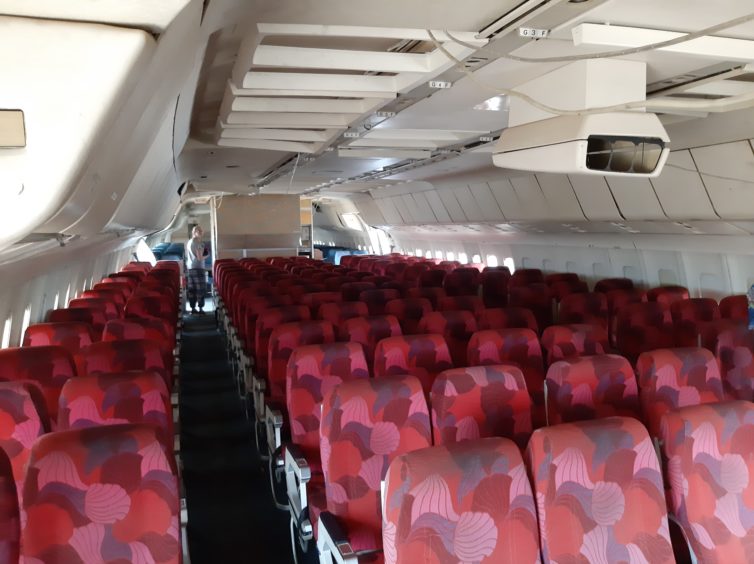
The L1011’s economy interior is still in pretty good shape, although the projector is missing – Photo: Jerome de Vries
The meal carts represented the short period of ownership by Kampuchea Airlines.
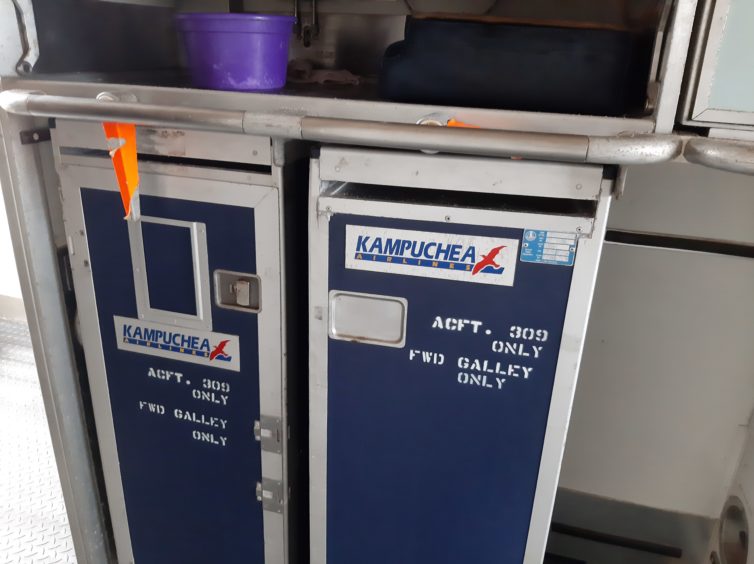
The carts show one of the previous owners of the aircraft — Kampuchea Airlines – Photo: Jerome de Vries
’œKambuja’, the ticket seller proclaimed as I photographed the meal carts. I suddenly understood what he was referring to.
’œOui, Kampuchea, Cambodia’, I responded.
’œAhh! Cambodge! Near Thailand!’, the man exclaimed. He seemed pleased with this information, his knowledge of the far-away nation perhaps aided by the fact that both Benin and Cambodia were once French colonies.
’œAlso Japan and America!’ I added, hoping the information would assist future tours he gives of this historic airframe.
Like the cabin, the spacious cockpit was in a good condition considering the ceiling escape hatch was hanging open. The instruments were largely in place, and it was impressive to see the complexity of the engineer’s panel. Scrawled in marker pen above some instruments were the words ’œOrient operations ex-BKK’, a hint of the aircraft’s former life at Don Mueang airport in Bangkok.
It appears that Don Mueang was one of the last major harbors of the TriStar, as now-defunct Thai Sky Airlines operated two TriStars from the airport in the mid-2000s. One of them (formerly HS-AXE) has been moved to a Bangkok market where it now serves as ’“ you guessed it ’“ a restaurant.
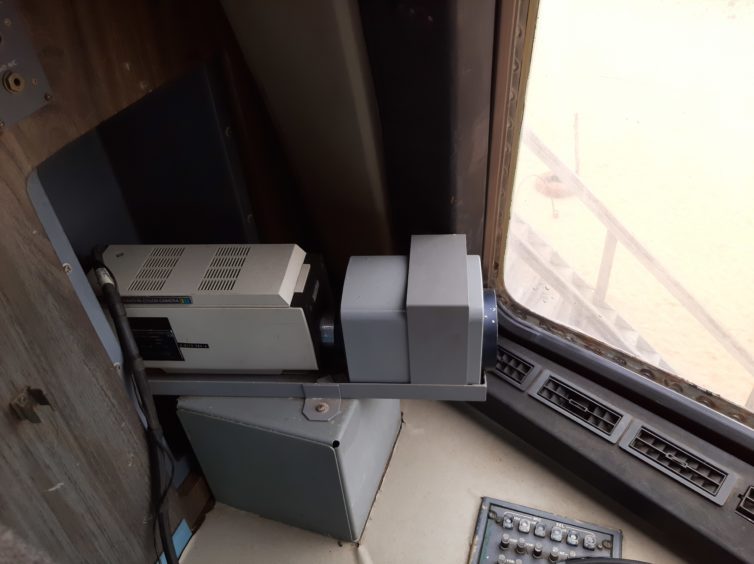
This camera was sitting by the left-hand window. Was it a normal feature of the TriStar cockpit? | Photo: Jerome de Vries
It was an incredible privilege to find this old TriStar and be free to explore its historic interior. The aircraft’s fate is unknown ’“ plans to convert into a restaurant are clearly not progressing fast, and it is well exposed to the elements. The ticket seller was amused by my enthusiasm for the aircraft. Maybe preserving “Barakah” in her current state isn’t such a bad idea – who knows, there may one day be hordes of TriStar enthusiasts travelling to Benin to have a look.
This story was written by Jerome de Vries from Wellington, New Zealand. When he isn’t working as a lawyer, he’s often thinking about where to travel next and what the most interesting way to get there would be.
This story was originally published in March 2020 and republished in May 2021.
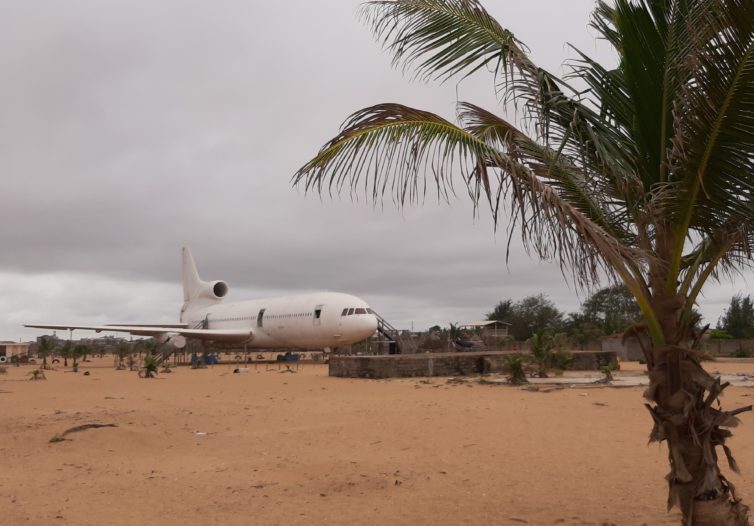

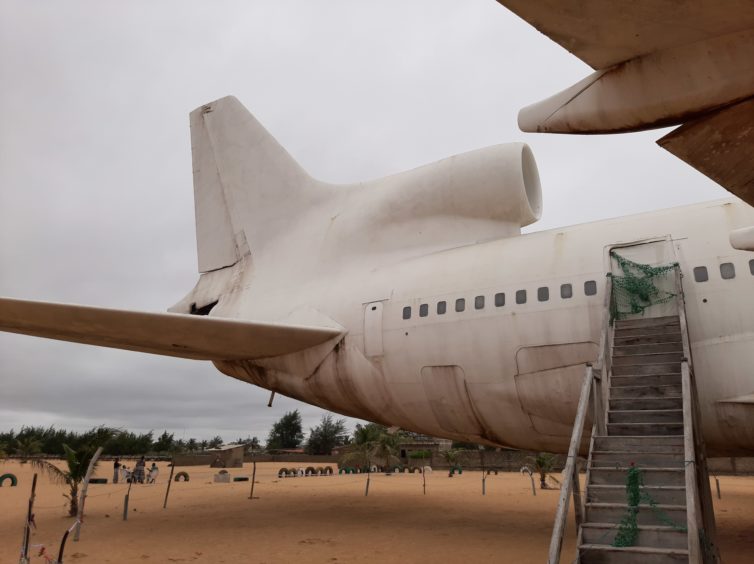
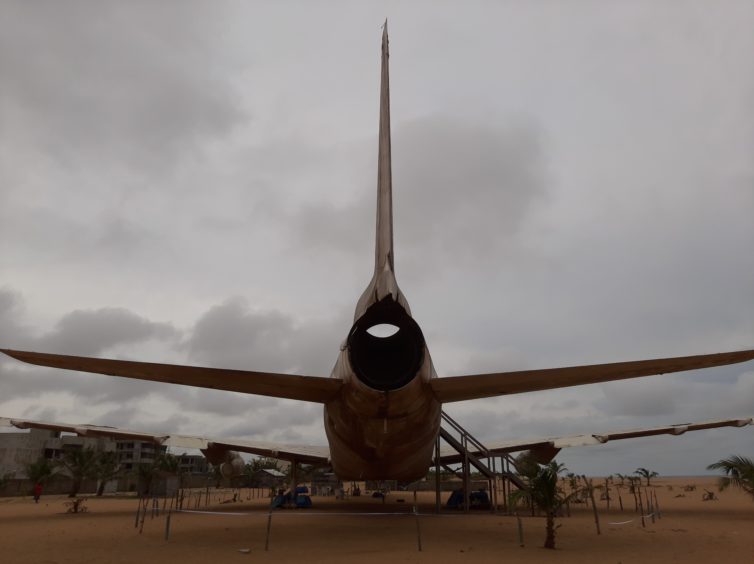
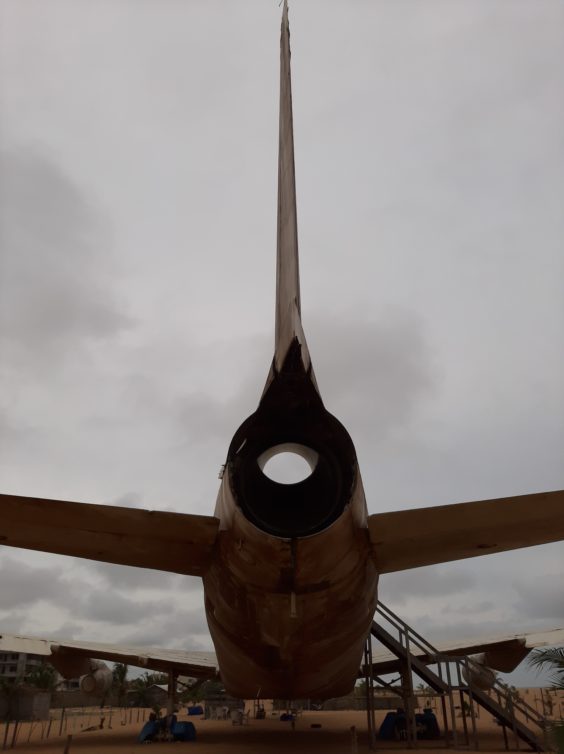
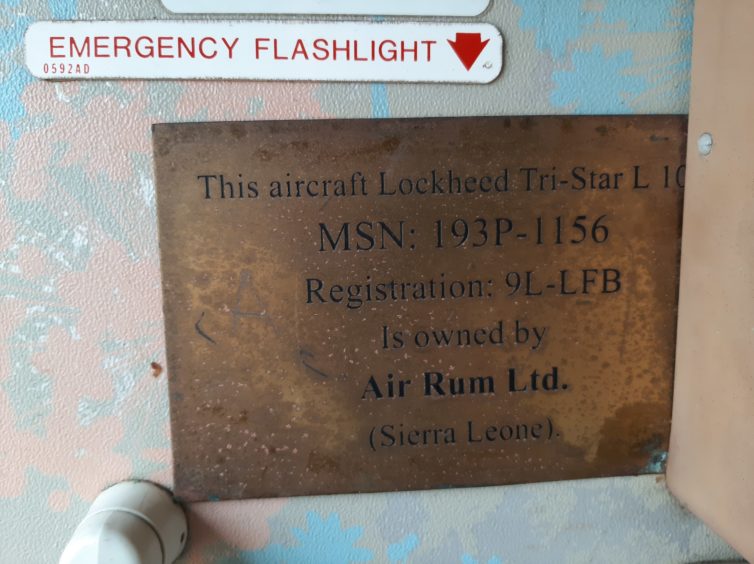
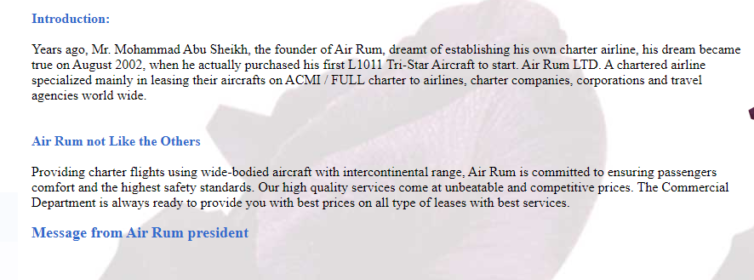
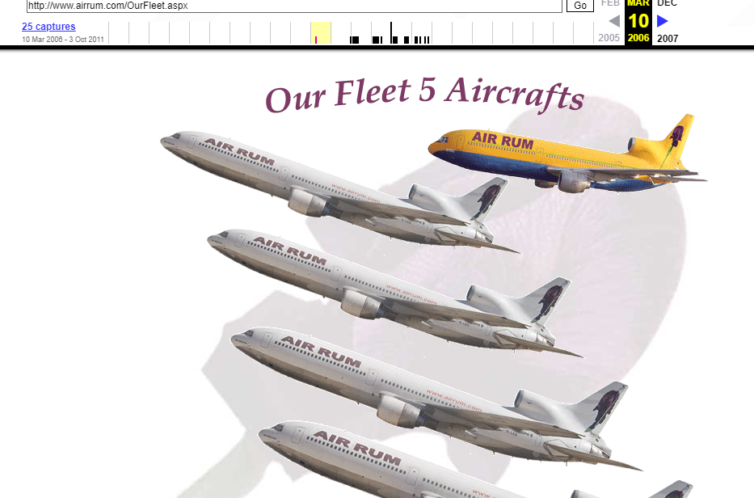
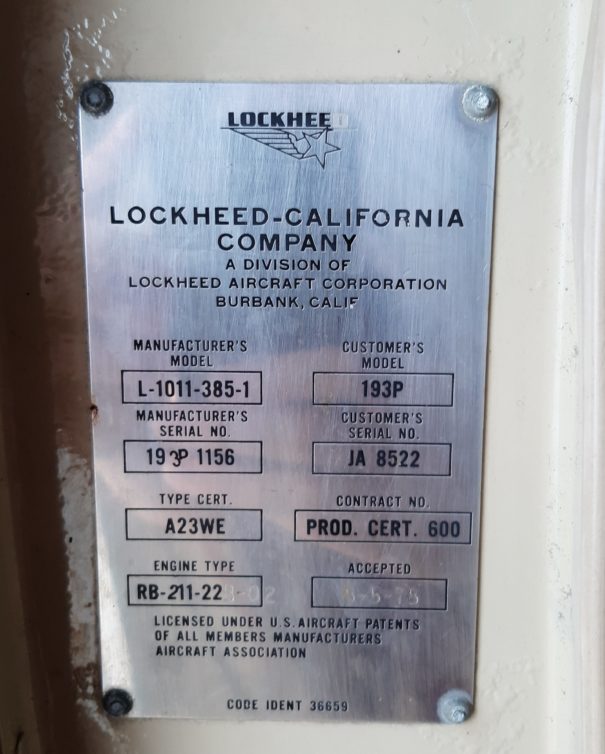
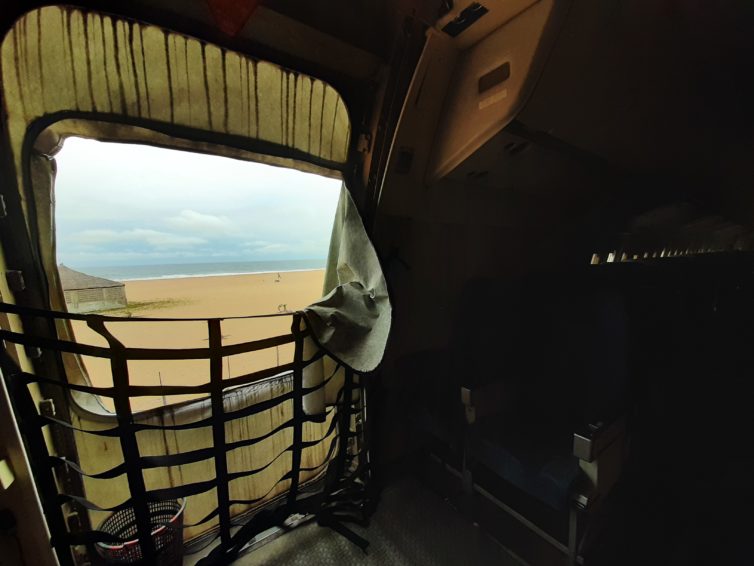
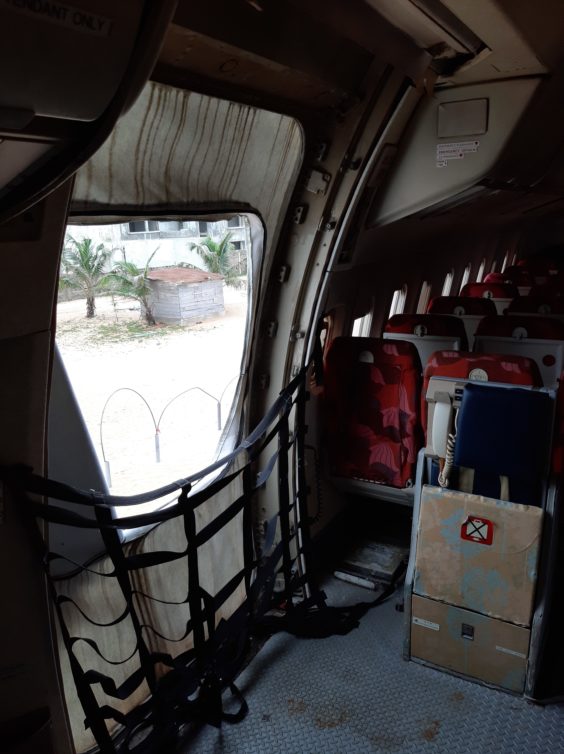
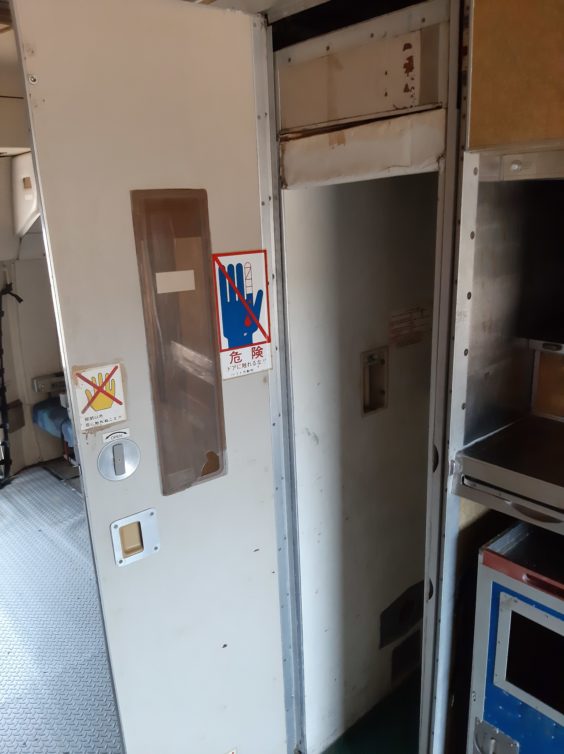
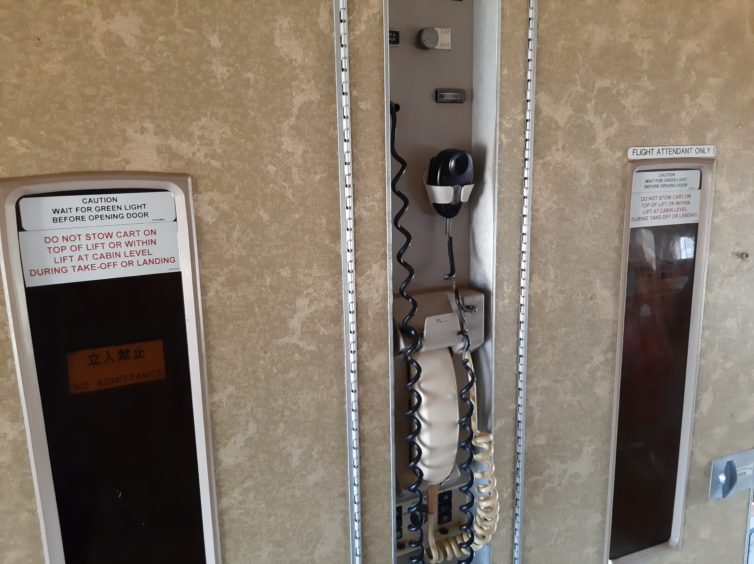
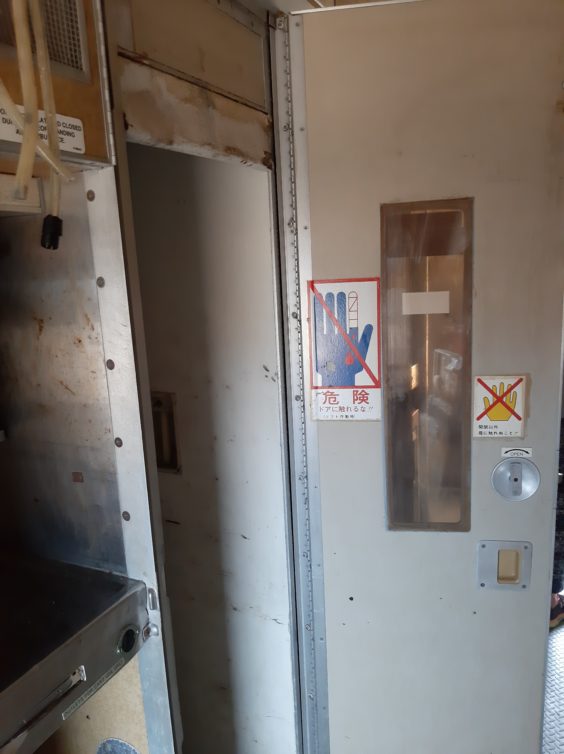
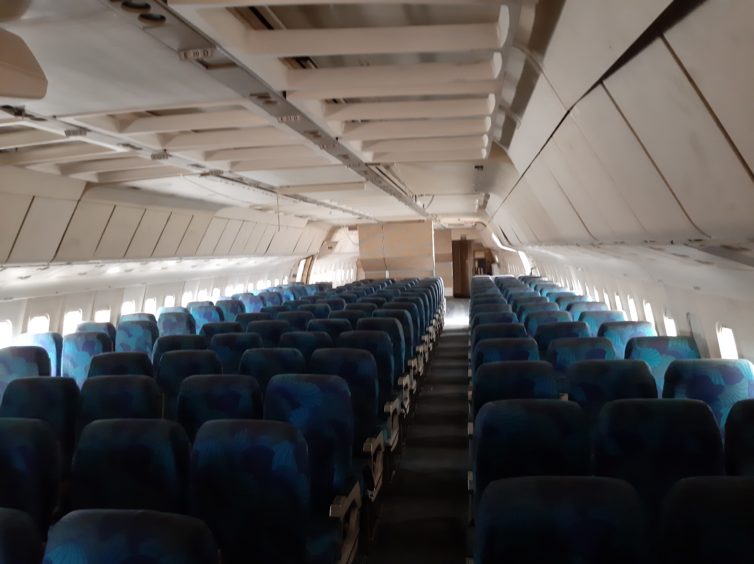
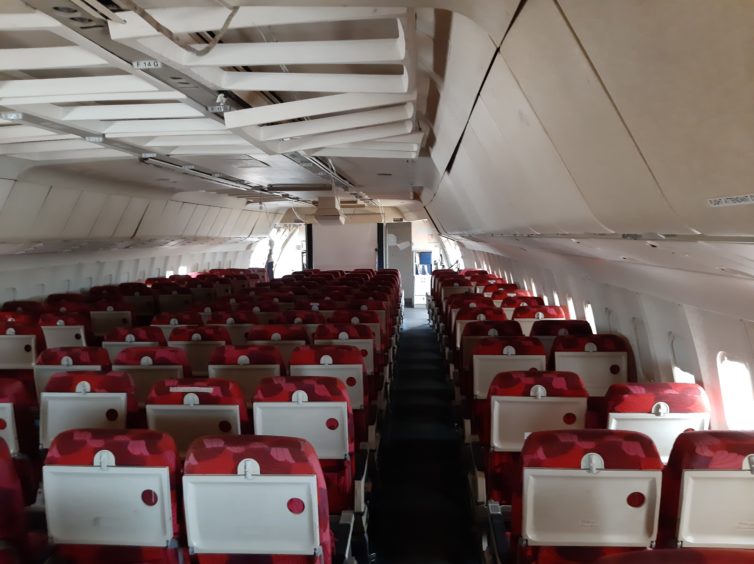
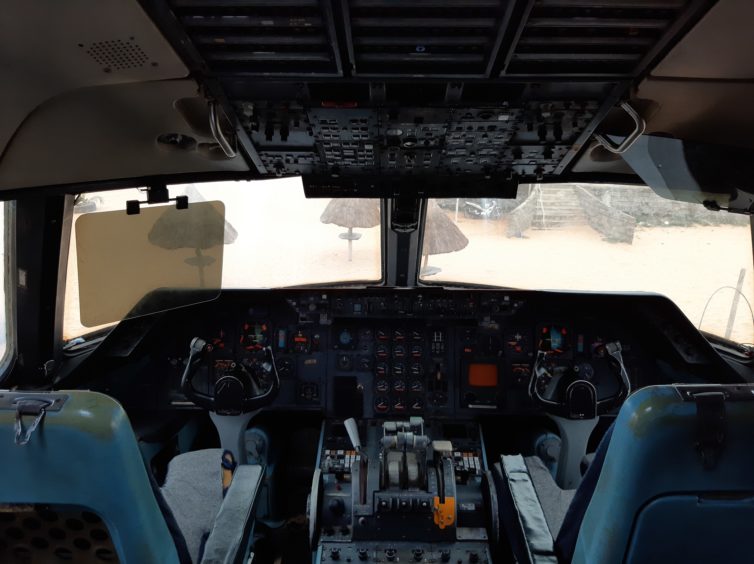
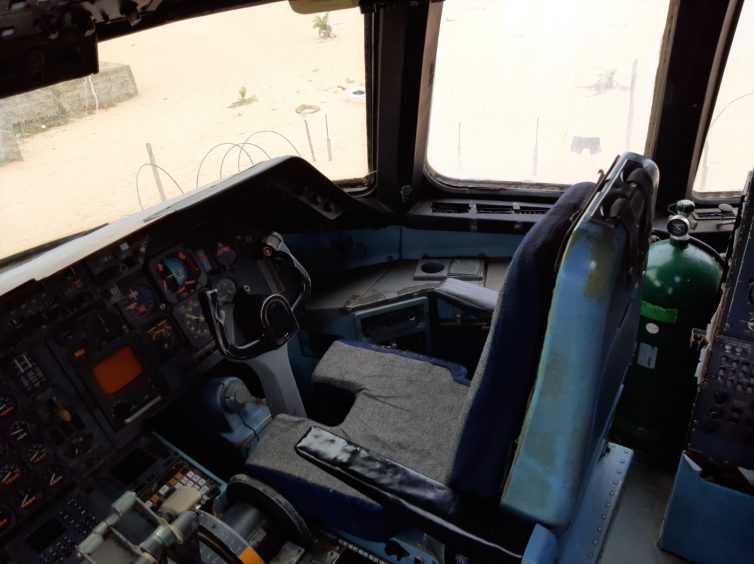
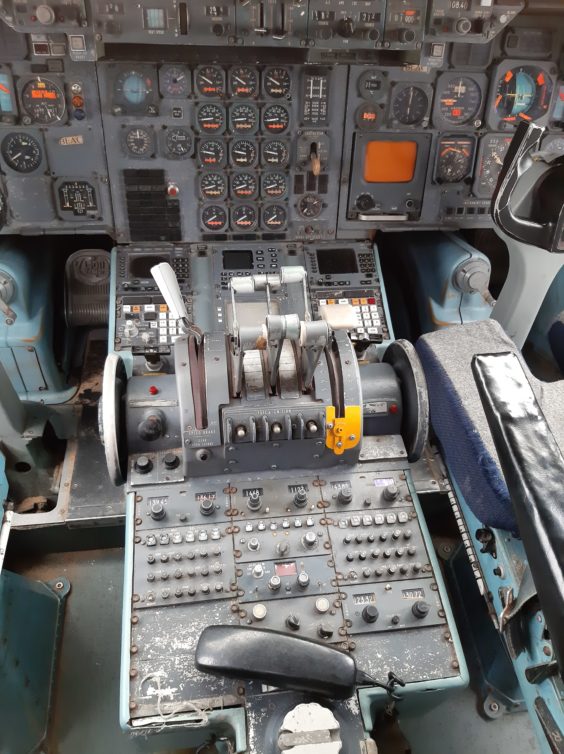
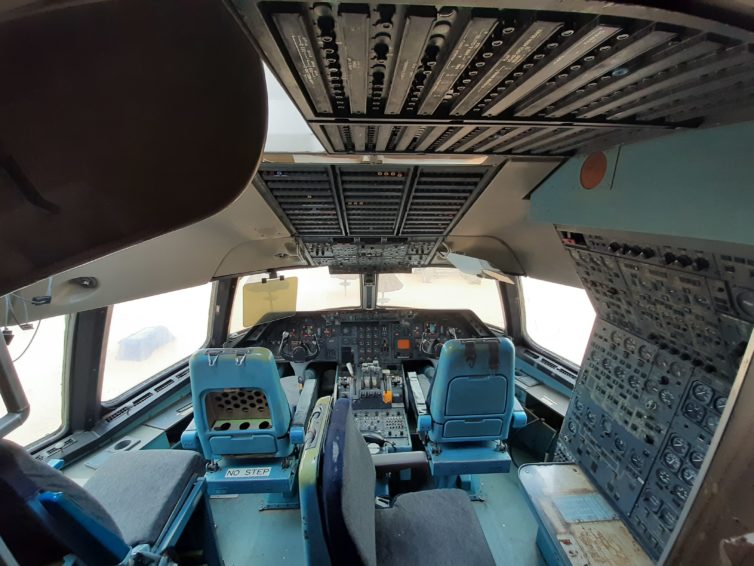
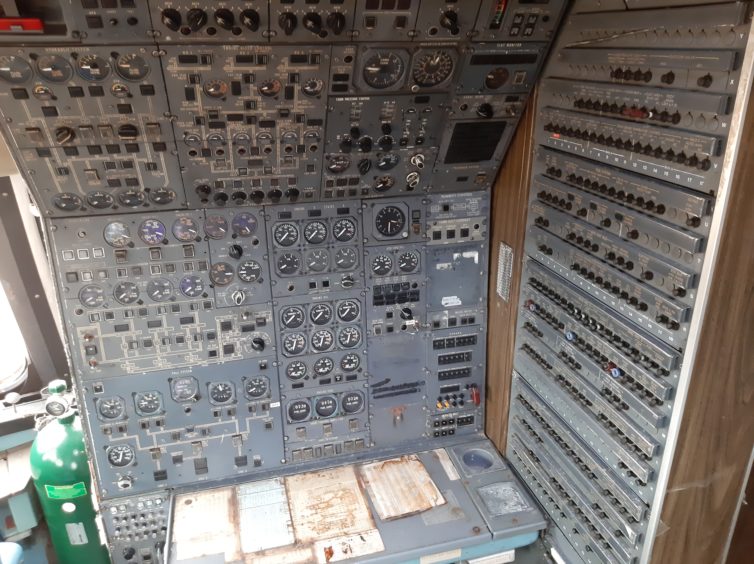
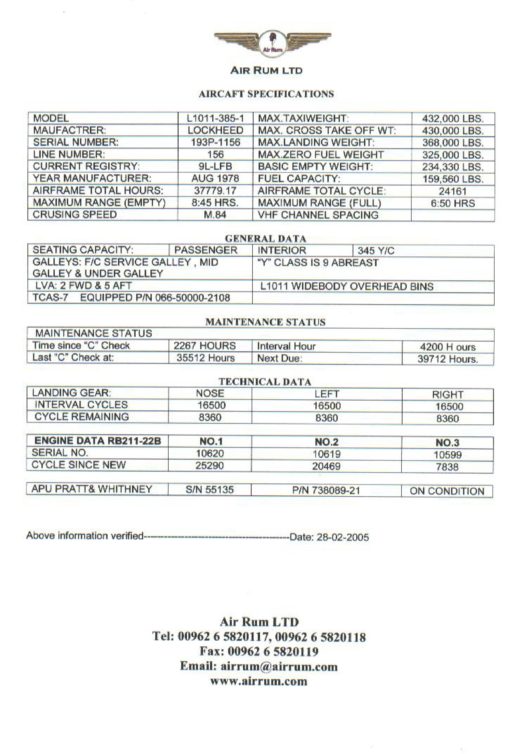
Wow! What an experience!!! The cockpit seems to be in great shape! Thank you for the story and for sharing!!
i was with air rum for a couple years. omar was a good guy but chained smoked himself with many worries. his brother was a partner and ran for jordan Parliament and lost. that pretty much emptied out the accounts of air rum. i still think 3 of their planes are parked in egypt where we left them for “storage” in 2008. they may still be there as far as i know. a couple of them were ex delta. all of his planes were the “round gauge” engine systems panel….not the “tapes”. 2006 and 7 was mostly nigeria. 2008 was benin. we had temporary licenses for those countries to match the tail number. we got chased out of cambodia around that time as well on some charters. glad (i think??) to see a plane left to some other use than being “a beer can in later life”. i just wish somebody would close the cockpit emergency exit hatch. next time you are there, if the “lockheed tristar” logo foot pedal covers are still on the rudders in cockpit, sneak in some tools and take them for me! i would buy that souvenir.
Pat the -500 is still parked here in Honduras. Looks a bit green on the hull. Haven’t been inside because whenever i pass by to say hi some Colonel asks when will the parking be paid. Told him that it was parked 7 years ago and I lost the parking ticket.
Thanks for the extra information Patrick, amazing that you worked for them! The foot pedal covers were still there – you can see them in the 4th picture from the bottom. Do you have any idea about the camera in the corner window?
that was a panoramic camera for passengers to watch the takeoff and landings in the cabin from ANA days. i know it was not used in air rum days. my bet the wiring runs from camera to VCR unit then to the overhead three lens projectors. it would be doubtful if that system even was used by the thai airlines too. come to think of it, i do not think air rum showed any movies on the hajj flights
Hi there Patrick!
I am an aviation enthusiast from NY who is interested in researching the histories of small/little-known airlines. Is there any way I could I ask you about your experiences with Air Rum? (highlights? quirks? best/most unusual moments, etc.) Being able to gather stories about such a little-known carrier would be a fascinating experience for me!
Sincerely, Peter
Hi Jerome, most interesting post about the L-1011.
I am a New Zealander too but live in the US and in the mid 1990s worked for Rich International Airways as a Flight Engineer on the L-1011. I”ll have to check my log book to see if I did operate the flight engineer panel N309GB!
Most of my flying career has been on ”old” steam gauge aircraft…. most on the Boeing 727, but also the Boeing 747-200 and now I”m currently Captain / Check Airman flying cargo around the Hawaiian islands on the Boeing 737 -200…. similar to the original 737s NAC had back in the late 1960s onwards
The L-1011 was a great airplane to fly and with Rich International , we flew to some interesting and different places throughout North America, Europe, Caribbean, South America, Hawaii and Alaska.
Great guys. Just fantastic. I was in kingman/az about 13y ago. There was a last twa L1011 stored. I helped scrapping the plane by buying one 20ft sea container full of stuff. Cockpit, hull, doors seats etc. Nowadays I integrated most of the parts in my house in Germany. Looks fantastic and the Tristar is still living here.
I flew the Tristar only as a passenger but he inspired me in becoming a cruiseship-addicted-Airline-pilot…. That s what I do today. Thank you L1011. Thank you for sharing your pictures and report here from Africa. Really great!!!
Absolutely amazing story and photos and to see this aircraft with basically pretty good internals, and that complete cockpit! I only ever had one L 1011 flight, with British Airways from Belfast to LHR, and very enjoyable it was.
Excellent story and photos, 10/10 !
Thanks Jerome for a fantastic report!
Oof, looks like I’m a little late to the party!
If by any chance Patrick (the former Air Rum employee) sees this, could he tell me how flying for the airline was like? (highlights? quirks? best/most unusual moments, etc.) It’s not often that you get to hear from people who flew such little-known and short-lived carriers!
I’m a Japanese aviation enthusiast. It’s very pleasure to see the pictures of ex-ANA’s L-1011 aircraft.
The aircraft JA8522 was used as a first international flight fleet as well as domestic of ANA. The seats, galleys, and a lot of stickers shows that aircraft was operated by Japanese carrer.
If I can visit Benin I have to see them!!
That has to be the coolest thing I’ve ever seen, hopefully it’ll be left as is, a very rare sight indeed.
This an amazing story of an aircraft type that marvel many around the world. At BWIA, in Trinidad & Tobago we operated 4 L1011-500s until they were retired after many years of faithful service.
One is still here at the Military Museum with a pending project to restore it livery. Hopefully, we will be able to get the project off the “ground” soon.
My dad did a few hours on that.. I would love to have the name plate from the L1 door? Cockpit looks more or less complete.. Great story for a great aircraft type (the 787/A350 of her day)
As an airplane enthusiast airplane buff in general I love to see stories like this and rarely see an aircraft abandoned in this condition normally just the shell. What kind of gives you a sad feeling seeing them sit quietly not knowing their history, what they’ve been through etc. Tho it’s not possible I wish we could save them all. Really appreciate you going to all the effort to share this! Or to the next mystery you uncover….
Fascinating story and everyone”s comments. Thank you.
Delta airlines. L–1011$ dfw atl ga and orlando fl. To dfw apr. And. Connection to delta. 191. Windsheeer. Crash. Delra l-1011. 2 august. 1885. Dl. L—1011. Thunderstorm!!
Thanks for an interesting article. My kid periodically flies in the Orbital Sciences/ now Northrop Grumman Stargazer while working launch missions.
There was a TWA L1011 parked at Tucson in 2001. Did a survey on that aircraft to model security cameras proof-of-concept. Cool feature was on lower deck had a full kitchen area with sink and cabinets like a home kitchen. Even a window over the sink. My first commercial air flight was on L1011 LAX-STL in 1982.
My first L-1011 Tristar flight was August 1974, TWA SFO-JFK. Of course, the whole experience of flying was different back then great service, comfortable seats, no fear of Middle East terrorists. Despite the moderate turbulence on that Tristar flight, the plane seemed to ride out the choppy air very well, due to advanced (for that time) technology. I subsequently flew on a couple of New York-Florida Delta Tristars, but the first one was a real take-your-breath-away experience!
She was VR-HOD (ex-CX) of Dragon Air . . and flew with Eastern Airlines before that
Loved the L1011 as a passenger. Flew it on TWA 842 overnight SFO to JFK many times First Class. When it made that final bank to the right with 3 engines in the rear and the wing hig into the rising sun it was silent as if is space. The flight continued to different London/Paris stops, and alternating to Cairo.
One morning when we landed at JFK and parked next to a leased L1011 with GULF AIR livery, as we declared, there was a crisis boarding that L1011 because of its livery. I swear. Dr. Bob Nadel long time TWA and road warrior.
Okay who’s here to help me cut the front nose off so I can put it in my garage and make one of the best sim rigs out there?
Reminds me of the Caravelle the Mexican drug cartel set down on the Baha Beach back around the 80’s.
What ever happened to that? I know they didn’t fly it out!
Wonderful article! If I ever find myself in that part of the world, I’d be sleeping on that beach. I’ve been an aviation nut since I was a kid and the TriStar was always the one that I had yearned to fly on. Sadly, my father typically only flew with United, so the non-worthy DC-10 was all I got from DEN/IAD one time. I did, however, get to take United’s first ever 777-200 on the same route in 1995. I believe it was the planes 1st or 2nd flight ever- in business class! So, some rep exists. Anyhow, loved the article!!
Moke,that is a great story, only wonder where people get these crazy ideas. Sorry to disagree but I’d take a DC10 over the Tristar anyday,United got a few of them when they purchased PanAm’s Pacific routes. They really didn’t fit in our fleet so they sold them off quickly but from what I saw maintenance wise was sketchy. Just my opinion. Many more 10’s still flying but only 1 Lockheed.
Hello Dennis,
What a epic story little did I know that such a graceful bird would be lying on the sands of Cotonou.
I am seriously thinking of a potential visit to that part of the world thanks to you.
A friend of mine is a pilot in Benin perhaps will try and ask him a few questions.
Thanks so much for the article.
I’ve been an aviation nerd since a very young age, when my parent’s would find me lying atop our barn with binoculars to view the exhaust trail of jets.
I only flew aboard an Eastern Airlines L-1011 in 1978, between AUS-BUF (AUS/BFO Int’ntl?). At 21 y/o, it was only my 2nd flight, but the sheer size and duo aisle had me in giddy amazement. I had a starboard window seat, just a few rows aft of the wing. The aircraft had a soft, kitten-like purr that almost lulled me to sleep, which my excitement prevented, lol!
I remember the takeoff and landing were as graceful as a bird. The safety briefing was shown on the center bulkhead screen that separated 1st class from economy – nevertheless, I felt that I was indeed a 1st class passenger, lol!
The in-flight service consisted of $1 beer/$2 cocktails and a generously delicious entre of beef stroganoff, with a slice of warm apple pie, served with a solidly frozen 4 oz cup of vanilla ice cream. Imagine my disappointment when my two hub return fight was aboard older narrow body, cramped aircraft, ugh!
The only other twin aisle aircraft I’ve flown were aboard AA DC-10s, which were similarly enjoyable, but featured the camera showing the takeoff and landing. I was disappointed when AA disabled the camera after the DC-10 crash in Chicago back in the 80’s. I think it was due to the presumption that passengers may have seen their aircraft as it descended in a nose dive and crashed, horrific.
There’s another L1011 at the airport in Accra. I have acfeeling that is a resteraunt too!
Hey Jerome, excellent article! It brought it all back to me from years ago in 96 when I worked on Tristars a while as a junior cabin crew member/ flight attendant. Your descriptions were solid and insightful. I loved the extra descriptive touches and context. These planes were workhorses with charm.
Best wishes,
Simon J Marton LLB LPC , a near -lawyer! (author ‘Journey of a Reluctant Air Steward’)
Stephan, that may be a deja vu of the IL-62 parked in Stà¶lln.
The L-1011 aircraft was the best flying platform ever to come off the drawing board. Her Rolls-Royce RB-211 engines were the loudest engines upon startup but the smoothest and most powerful during ops. They were a pleasure to work on as I worked as an A&P for TWA on their L-1011 fleet for 28 years until the airline was bought by AA who I’ve been with for the past 19.
Re the comment that the DC-10 was a better a/c and is still flying…….I beg to differ.
The DC-10 was in a race to get off the assembly line with the L-1011 and won by over a year. But that race produced a visually unsightly ( ugly…if you will) aircraft that was plagued by numerous mechanical defects which caused catastrophic failures in numerous systems causing major loss of life incidents…..ie AA Chicago loss of wing engine causing aircraft to roll over and crash on takeoff…..no survivors.
United Sioux City Iowa cornfield fan disc explosion #2 (tail) engine knocking out all 3 hydraulic systems which were ridiculously routed together creating zero redundancy and loss of control of aircraft.
Then there were the numerous blown tire incidents through the years along with the rear cargo doors being blown out periodically.
The only reason some are still flying is they’ve been reinvented through the years and even renamed (MD-11) due to their terrible reputation.
The L-1011 died when Rolls-Royce aircraft engines went bankrupt.
The very few L-1011 crashes were due to either pilot error……Eastern 401 Florida Everglades flew into terrain after inadvertently knocking off autopilot while being distracted trying to change a landing gear light bulb, aircraft flew itself into the ground and TWA 842 JFK faulty stall warning indicator…. …..pilot rejected takeoff, but had already become airborne. Subsequent “heavy” crash landing caused landing gear collapse and fire which destroyed aircraft but all survived..NO loss of life except 2 dogs in cargo compartment.
Delta 151 DFW was caused by windshear.
Hi Francis, do have access to any L1011 cockpit instruments? We are trying to rebuild the 9Y-TGN cockpit.
Sixteen years working the L1011 as Cabin crew for ATA Airlines. Flew every nook & cranny of this wild Earth. This is an engineer’s plane, designed with back ups to back ups for inflight mx issues. Lady1011s are beautiful birds. Thank you for a great article, made me smile. Tracey Lane
My Father, William Hays, was a program manager for the L-1011. He passed way in October of 1978. Our entire family went to Japan in 1958 where Dad was a program manager on the Lockheed P2V project at Mitsubishi Japan. Then in 1962 we headed to West Germany for his similar work on the F104 program. He was an avid private pilot as well and I am working on documenting his life based around his several pilot log books. I have already discovered that his first flying lesson took place in a Taylor Cub at the age of 20 in 1936. This Cub was flown in 1934 from Pennsylvania to California (via Seattle) by William Piper! Another entry in his log books identifies an aircraft that was later used in a “B” movie about chasing some drug runners. I believe the movie was made in 1939.
I would welcome any suggestions and/or ideas about how to put together what I’m calling “A Pilot’s Logbook”.
I am a retired Navy pilot who flew the Lockheed P-3 Orion. That was a derivative of the Lockheed L-188 Electra. In 1974 I flew on an Eastern Airlines L-1011. After landing and chatting with the captain he told me he’d flown Electra’s for many years and then moved over to B-727. Eventually, he upgraded to L-1011. On his very first flight in the TriStar, he was so puzzled because the flight control system seemed so familiar. He investigated and discovered that the Lockheed engineer who designed the flight control system for the Electra and subsequently retired, was recalled to Lockheed to design the flight control system for the L-1011. He said. “Iif you closed your eyes it felt just like flying the Electra.”
Having the privilege of flying on this wonderful plane and having so many fond memories with Eastern Airlines and Rich International the places I’ve been and stories I could tell but that’s for another time . Thanks for sharing
Andy-
That aircraft in Accra is a DC-10. And yes, it’s a restaurant.
Hello everyone.
I worked with Saudi Arabian airlines from 1976 to
1997 and rcvd 17 on these giant birds as part of the fleet. While we operated these acts on such a short flight route from Jeddah to Taif with total of 20 mins flt time and maybe 30 mins block time, Rolls Royce upgraded the RB211 engines from 22b to 524b. What a golden memory.
Thanks for sharing wonderful images.
Great story, thank you. I flew the L10 for TWA, loved the airplane and coming across your story was like seeing an old friend!
wow this looks like old school days, my grandfather was a pilot and I show them your article, and he loved this because one of his close friend flew the L-101. He told me about their training, How they meet, How he meets my grandma.
Thanks for sharing this. My grandpa already takes screenshots of the pictures.
Ethan, it’s so great to hear you appreciate your grandfather’s contribution to the aviation industry .I’m sure he is overjoyed having a grandson whose interested in his career and I’m sure you will benefit from his knowledge. Bless you.
What a interesting story I too live in Wellington New Zealand. I am a big fan of the Tristar I was lucky enough to fly in RAF one once to Canada from the UK.
Hi there, We used to call this big boy Hot Queen which could stand Saudi Arabia’s super hot boiling temperature round the year. Our top item used to be High Oil pressure specially on No.2 Engine with smaller flight legs. I have lots of memories floating around Maintenance planning desk to hanger production.
I have flown quite frequently between Jeddah to London and enjoyed big leg room.
It’s wonderful here in Canada I call my second home.
Thank you for your attention.
It’s such an Amazing Story. I am Beninese 🇧🇯 who’s currently living in the US. I am so happy I came across this well detailed article made by Jerome I was able to learn more about that Plane I always see while I was in my home country Benin. I even took a trip back to Benin 🇧🇯 in October 2022 and the plane was still standing there. It’s weird that this bird has an immense history but I was never told about it or neither got close to it. I always pass by it. Next time I go back home I’ll definitely get close to the plane. Taking care of this plane and Living it the way it is and not turning it into a restaurant would be an awesome idea because it could attract very visitors. BENIN 🇧🇯 IS Full of History. Feel free to take your next trip there. And certainly if you have watched OR hear of WOMAN KING . The movie was based on a true story of Benin ( AGOOJIE) . That’s why Even recently gotten a Giant statue called The AMZAZON Statue of Benin ( a warrior woman). This statue I am referring to is also located nearly 5 to 10 minutes from the Plane. So it will be amazing to visit both if you were just visiting one.
I was a Delta 500 Pilot and retired on the L–1011 in 1994. After retirement, I went over to Sri Lanka,
and flew the L-10 for them. I was fortunate to have the president of Sri Lanka on board a short flight
from the Maldives to Colombo. She was a very nice Lady and was very interested in the operation of
aircraft and asked very intelligent questions. I loved flying for Air Lanka, and the L-1011. I flew the DC10
at Western Airlines. prior to the merger with Delta. I flew the last DC 10. to Atlanta and must say the
L-10 was a better airplane to fly from a pilot standpoint. The DC-10 Was not bad, but had it’s problems
. I’m almost 90 now and still have lots of stories.
Hello Gary, thank you for sharing. I was reading quickly to see which plane you would say was the best to fly :). Worth the wait.
David
After Graduating Embry-Riddle in 1985, hired by Delta at DFW, just in time for DAL 191 L-1011 crash, what a nightmare… 2 yrs in DFW, 10 in MCO; so saw a lot of L-1011’s probably all of them.
BTW, one major reason for flying so well is the horizontal Stabilizer is an active flight control, unlike any other plane of that era… I used to climb up the S-duct and scream at cabin service girls walking on/off the service trucks and they could not tell where the voice was coming from!!! Its a great plane that had very bad vendors, switches, valves, etc… We called it the “Tri-Tanic” 😉
We taxied and ran up engines quite a bit, notorious for tail pipe fires from roll backs…DFW FD sprayed powder in the tail of one, automatic engine change. Since ’97 I am now an Avionics/Software Systems Engineer, was on Shuttle landing systems, B787 and many MIL planes, now on GE F-35 Adaptive Engine Transition Program Fuel Control Prototype.
Thanks for posting this. We lived in Cotonou near the airport in the early 2010s and I saw this plane every day (before it was towed to the beach, I guess). I always wondered what the deal was. The rumor I heard is that it was abandoned when the owner was caught up in some kind of gold smuggling scheme. So glad to see it’s been given a second life. I would have loved to go inside.
I’d really like to see one of these in person someday.